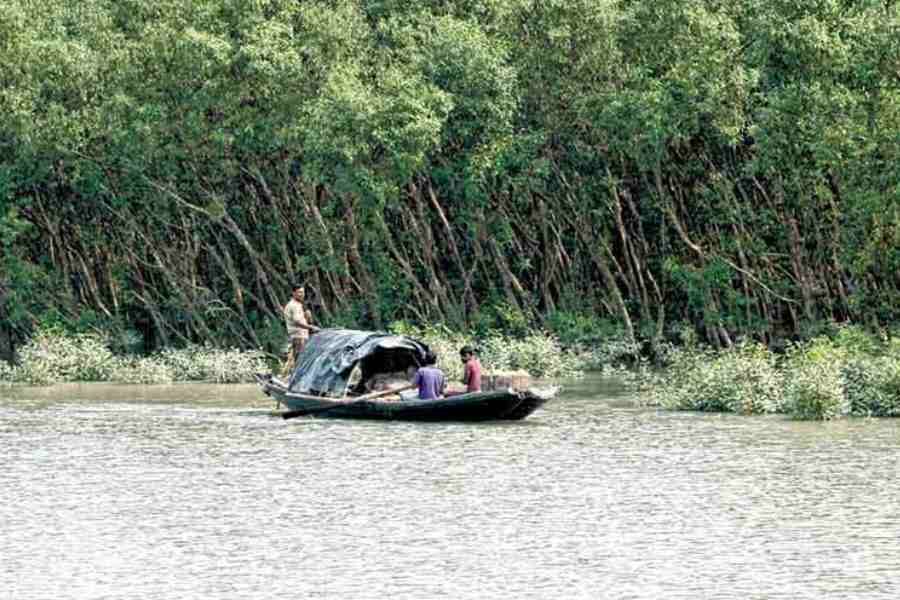The Sunderbans was declared a Unesco world heritage site in 1987, a Unesco biosphere reserve in 2001, and a Ramsar site in 2019. The protected National Park here houses the threatened Royal Bengal tiger as also other rare animals, reptiles, flora and fauna. The beauty of the coastal landscape of tidal rivers, criss-crossing creeks and canals frames the lives of a historically marginalised agricultural and fishing community. Of the 4.37 million people who live here, around 34% fall below the nationally designated poverty line.
We were on a trip to the region for a small pilot study on climate change and migration in the Basanti and Gosaba community development blocks. In the Sunderbans, mono-crop agriculture and divided and small land holdings severely limit household incomes. While over 60% are agriculturists, nearly 50% own no land except for their small homestead lands. Most are marginal farmers or landless agricultural workers looking to work on local farms and in construction and road work.
Rural economic backwardness intermeshes in complex ways in this coastal land with changing climatic factors. The increasing frequency of episodic climatic events like cyclones has meant large-scale loss of land, habitat and livelihoods. These are compounded by everyday environmental hazards: resource pressures related to sea-level rise and land salinisation and increasing reliance on degraded resources and land erosion, which has led to the gradual disappearance of islands and dislocation of communities.
State policy remains tied to limited and poorly-governed rehabilitation and relocation of climate-threatened households. Intense academic and policy debates surround the Sunderbans. However, the broader political economy of West Bengal is less frequently brought into these discussions. While the official rate of unemployment in the state has declined, West Bengal ranked fourth among Indian states from where people migrate for employment (2011 census). Halting industrial development, the lack of regular employment opportunities and a low-wage rate in rural and urban areas are the dominant reasons for the migration of Bengali workers. An estimated 75% of households in the Sunderbans send out at least one member of the family for work. Men travel to rural Andhra Pradesh, sometimes to the Andamans, to work as seasonal agricultural labour, working for two or three months, earning between Rs 20,000 to 40,000. In Andhra’s farms, the men work 12-14 hours a day, standing in fields in knee-deep mud in unbearable heat. Many incur deadly skin ailments. “Kathin shram, kathin rog, mrityu,” is the description offered by a former migrant. In a small fishing hamlet, a few fishermen go to Surat for sari embroidery, earning Rs 20,000 per month. With a 12-hour work day, living in congested rooms in unsanitary conditions, they can work for only two or three months in a year.
The household economy revolves around earnings from two or three months of migrant work and marginal earnings from local resources (farms, construction, road works, loading and unloading, fishing, honey collection) combined with loans. Most people live in mud huts. Villagers spoke of reduced rations, from five kgs to two kgs of rice; rarely do children, particularly girls, move beyond middle school; and there is no work for the women to supplement the family’s meagre income. Even the handful of college graduates find it hard to survive. A headmaster of a private school receives a monthly salary of Rs 6,500; others work on temporary projects with CSOs. While several welfare schemes are in place, most agree that work is their foremost need.
It is difficult to single out which political party is responsible for the region’s backwardness. The Marichjhapi massacre of refugees had occurred during a Leftist coalition, which failed to come up with any specific policies for the Sunderbans during 33 years of rule. The current regime is hands-on in its professed delivery of welfare and in its close surveillance of who gets what. This is just the way democracy works.
Supriya RoyChowdhury is Visiting Professor, Urban and Mobility Studies Programme, National Institute of Advanced Studies, Bangalore










